

Thinking skills are the most important skills that students can learn. They allow students to learn new material, to solve problems, and to make informed decisions. Robert J. Marzano
Introduction to Thinking Skills
Thinking skills are one of the eight Evidence Based Learning skills proven by research to maximise learning.

Thinking skills are the mental activities we use:
– to process information
– to make connections
– to make decisions
– to create new ideas
Adapted from: Thinking Skills – The Peak Performance Center 2023

We need thinking skills:
– to process information
– to organise information
– to remember things
– to ask questions
– to solve problems
– to make connections
– to make decisions
The Development of Thinking Skills
In 1956, having researched thousands of questions routinely asked by teachers, Benjamin Bloom organised these questions into six categories depending on the thinking skills needed to answer them.
These six categories came to be known as Bloom’s Taxonomy.
Different types of thinking take place at each level of the taxonomy. Generally speaking, easier types of thinking are at the bottom and more difficult types of thinking at the top.
This means being able to use what you have learned to make something new.
This means being able to make judgments about the information learned based on your own opinions or criteria.
This means being able to break down the information into smaller parts and see how they fit together.
This means being able to use what has been learned to complete a task.
This means being able to make sense of the information learned by explaining or writing it in your own words.
This means being able to recall information already learned.
Bloom’s Taxonomy is generally seen as a ladder of progression for thinking skills
Different types of thinking take place at each level of the taxonomy.
Generally speaking, easier types of thinking are at the bottom and more difficult types of thinking at the top.
Their biggest change was to use verbs instead of nouns to describe the action needed at each level rather than just the name of each type of thinking.
1956
Bloom’s taxonomy used nouns that named the thinking skill at each level
2001
Anderson and Krathwohl used verbs that tells us the action needed at each level
1956 Bloom’s original model
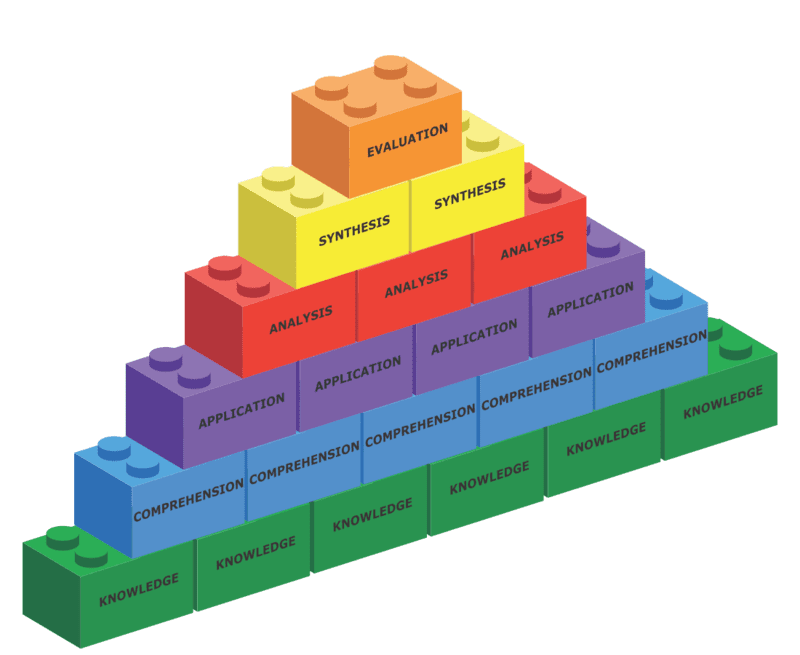
the 1956 model used nouns to name the type of thinking at each level
2001 Anderson and Krathwohl’s revised model
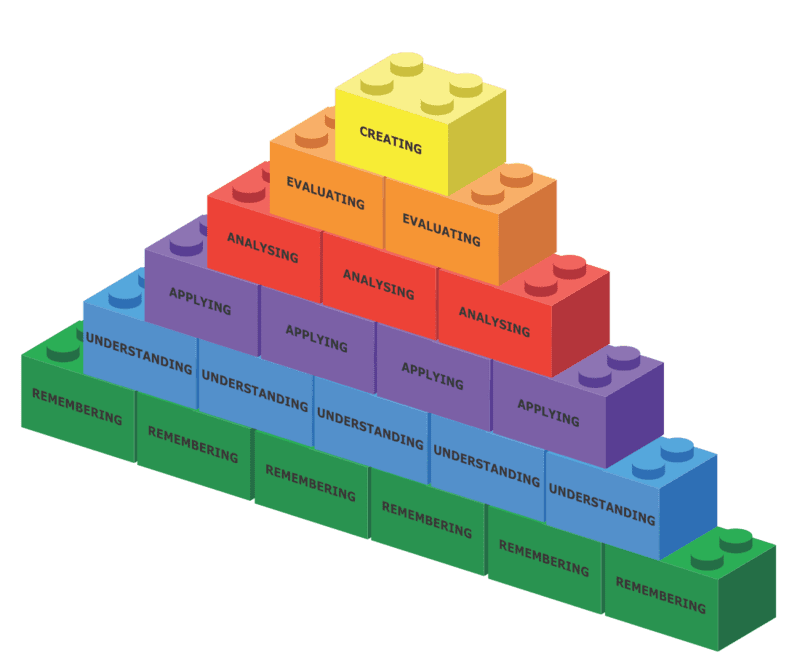
the 2001 model used verbs to describe the action needed at each level
In the 2001 model, creating has replaced synthesis and this skill is now top of the taxonomy.
In 2001, Bloom’s taxonomy was revised – providing learners with clearer objectives of what was expected of them
In 2001, Anderson and Krathwohl revised the 1956 Bloom’s taxonomy model. The Bloom’s taxonomy nouns at each level were replaced by verbs – providing learners with clearer objectives for what is expected of them.
What’s more, the most important two levels, ‘evaluating’ and ‘creating’, were swapped to make creating the main goal of learning.
Bloom’s Taxonomy Words Point The Way To Clearer Outcomes – Nov 2018
Anderson and Krathwohl’s 2001 model was a verb-based model that listed the actions at each level
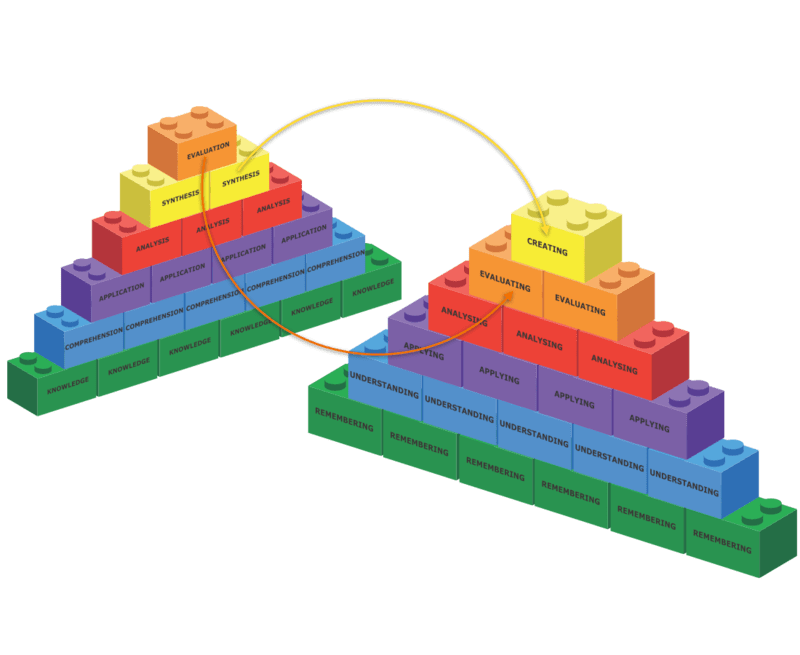
1956 – NOUNS name each skill
2001 – VERBS name each action
A Teacher’s Guide to Bloom’s Taxonomy – Nov 2019
Bloom’s Taxonomy is a model of 20th century thinking skills that was created in 1956 and revised in 2001
The 2001 model used verbs to describe the action needed at each level

Like other taxonomies, Bloom’s is hierarchical, meaning that learning at the higher levels is dependent on having attained prerequisite knowledge and skills at lower levels.
You will see Bloom’s Taxonomy often displayed as a pyramid graphic to help demonstrate this hierarchy.
Using Bloom’s Taxonomy to Write Effective Learning Outcomes Jessica Shabatura – University of Arkansas – July 2022
Reasons in favour of using Bloom’s Taxonomy to improve thinking skills

Bloom’s taxonomy has been a useful framework for educators and learners for close to 70 years – and with good reason.
It provides clear and relevant pathways for learners to move through the orders of thinking, from basic remembering to more complex skills such as evaluating and creating.
What is Bloom’s taxonomy? – Feb 2023 – Dzemila Okanovic
Reasons in favour of using Bloom’s Taxonomy to improve thinking skills

The fact that Bloom’s taxonomy can be applied to any cognitive content intended for learners to learn is what makes this framework so powerful.
For teachers, Bloom’s taxonomy is a practical tool to use, providing a framework in which to plan challenging lessons that help to ensure learners’ progress is maximised – a fundamental tenet of successful teaching.
Among its many uses, Bloom’s taxonomy provides an excellent foundation for lessons, as it can be used as a framework in which to deliver appropriate activities, assessment, questioning, objectives and outcomes.
Applying Bloom’s Taxonomy to the Classroom – July 2019 – Technology for Learners
The general order that thinking and learning skills develop:
Metacognitive thinking skills
+
Non-Cognitive Skills (the attitudes and behaviours for learning – such as motivation, perseverance, and self-belief)
There are ALSO three key 21st century Thinking Skills…

The three thinking skills identified as being necessary for the 21st century are:
– Creative Thinking
– Critical Thinking
– Problem Solving
21st Century Skills
Bloom’s Taxonomy of thinking skills

The Bloom combinations needed for the three 21st century thinking skills:
Creative Thinking
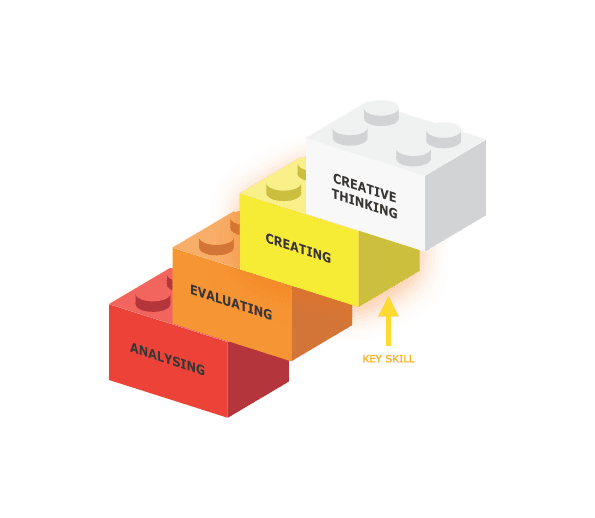
Critical Thinking
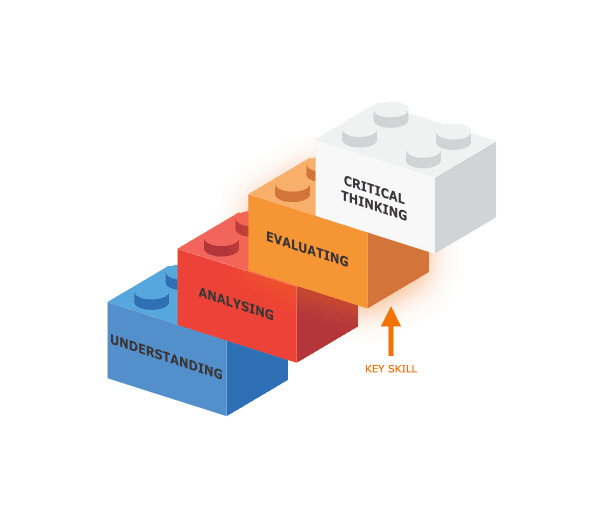
Problem Solving
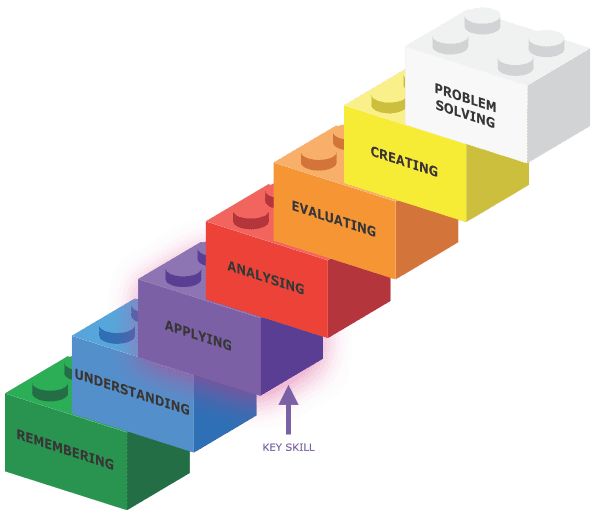
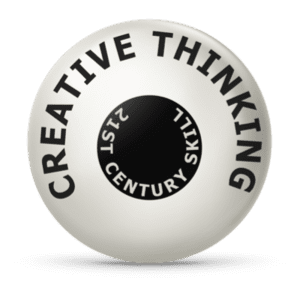
Creative Thinking
Creative thinking is a fresh way of looking at problems.

Creative thinking is a way of looking at problems or situations from a fresh perspective. It is all about developing innovative solutions to problems.
Creative thinking can be stimulated both by an unstructured process such as brainstorming, and by a structured process such as lateral thinking.
Cognitive Thinking Skills – SkillsYouNeed
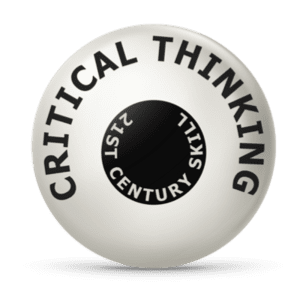
Critical Thinking
Critical thinkers look for evidence that something is true or false.

Instead of accepting ‘at face value’ what they read or hear, critical thinkers look for evidence and for good reasons before believing something to be true or false.
Adapted from: What is Critical Thinking – University of Leeds 2023
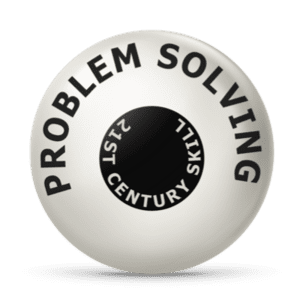
Problem Solving
Problem solving is needed every time a learner faces a task that they cannot do.

Knowledge alone is not sufficient to make learners succeed in the 21st century. Learners need to attain 21st century skills such as problem solving, creative thinking, and metacognition.
Problem solving is one of the fundamental human cognitive processes. Whenever a learner does not know how to complete a task, they will need problem solving.
21st Century Skill “Problem Solving”: Defining the Concept – Rahman Asian Journal of Interdisciplinary Research Vo 2 Issue 1 – March 2019
Conclusion
Since 1956 there has been three key developments in thinking skills
In 1956 Benjamin Bloom created a taxonomy of 6 single thinking skills:
Bloom’s Taxonomy is generally seen as a ladder of progression for thinking skills
the thinking skills above are skills that usually involve a single type of thinking at a time
1980’s onwards
More complex 21st century skills were identified – each skill needs at least 2 types of thinking…
Conclusion
Bloom’s 1956 model was a noun-based model that listed the names of the skills needed at each level

Anderson and Krathwohl’s 2001 model was a verb-based model that listed the actions needed at each level

Evidence-based quotes on Bloom’s Taxonomy.

This research could be used for teacher CPD on the benefits and drawbacks of using the taxonomy.
Research that supports using Bloom’s Taxonomy

Bloom’s Taxonomy was built on earlier research by Piaget and Vygotsky
“Thinking skills are developed by cognitive challenge”
Bloom’s Taxonomy of thinking skills (what he called ‘the cognitive goals of education’) has been widely used by teachers in planning their teaching.
Bloom identified a number of basic or ‘lower order’ cognitive skills – remembering, understanding and applying and a number of ‘higher order’ skills – analysing, evaluating and creating.
Bloom’s Taxonomy built on earlier research by Piaget and Vygotsky that suggested that thinking skills are developed by cognitive challenge. Teachers need to challenge pupils to think more deeply and more widely and in more systematic and sustained ways.
Adapted from: Personalised Learning: A Guide for Teachers – Robert Fisher – Learning and Teaching Reflection Framework – The Highland Council
Research that supports using Bloom’s Taxonomy

Bloom’s taxonomy (1956) of objectives and skills includes six levels of learning that can help you structure effective learning outcomes, teaching activities and assessments (Vanderbilt University).
Using Bloom’s Taxonomy allows you to link your outcomes to the tasks you want your students to demonstrate. It can also act ask a guide on what level of learning you want your students to achieve.
Learning Outcomes with Bloom’s Verb Guide – Liverpool University – July 2019 – www.liverpool.ac.uk
Bloom’s Taxonomy works
Using Bloom’s Taxonomy improves learning outcomes.
Research that supports using Bloom’s Taxonomy

Bloom’s Taxonomy provides a usable structure for teachers
The greatest strength of the taxonomy.
Anderson (2000) argues that nearly all complex learning activities require the use of several different cognitive skills. Like any theoretical model, Bloom’s Taxonomy has its strengths and weaknesses. Its greatest strength is that it has taken the very important topic of thinking and placed a structure around it that is usable by practitioners.
Those teachers who keep a list of question prompts relating to the various levels of Bloom’s Taxonomy undoubtedly do a better job of encouraging higher-order thinking in their learners than those who have no such tool.
A Critical Appraisal of Bloom’s Taxonomy – American Research Journal of English and Literature 2016
Research that supports using Bloom’s Taxonomy

Using Bloom promotes critical thinking
“Higher order questions put advanced cognitive demands on pupils”
Higher order questions are those that the pupils cannot answer just by simple recollection or by reading the information “verbatim” from the text. Higher order questions put advanced cognitive demand on pupils. They encourage pupils to think beyond literal questions.
Higher order questions promote critical thinking skills because these types of questions expect pupils to analyse, synthesise, and evaluate information instead of simply recalling facts.
Adapted from: Higher Order Questions – Oct 2014
Critiques of Bloom’s Taxonomy

Bloom’s Taxonomy “gives the mistaken impression that some of these skills are more difficult and more important than others”
“Learning is not a hierarchy or a linear process”
The problem is that both (the 1956 and the 2001) versions of the taxonomy present a false vision of learning.
Learning is not a hierarchy or a linear process.
This model of the taxonomy give the mistaken impression that these cognitive processes are discrete, that it’s possible to perform one of these skills separately from others.
It also gives the mistaken impression that some of these skills are more difficult and more important than others.
Here’s What’s Wrong With Bloom’s Taxonomy: A Deeper Learning Perspective – March 2018
Critiques of Bloom’s Taxonomy

Bloom’s Taxonomy is teacher-centred and is not learner-centred.
“The taxonomy does not consider the learner”
The taxonomy does not consider the learner and the differences that each learner brings to the table. Motivation, their intellectual values, their past experiences with the content, their differences in cognitive processing: none of these are considered.
The approach is based on the belief that all learners are at the same place in their learning, which is inherently false. In short, Bloom’s Taxonomy focuses on abstract cognitive domains and not on the individual learner. Bloom’s Taxonomy is teacher-centred and not learner-centred.
Why It May Be Time To Dump Bloom’s Taxonomy – Dec 2021 technotes – educational research
CONCLUSION

Developing pupils’ ability to think more skilfully can lead to better learning and increased attainment.
Thinking Skills

Far and away the most effective factor in raising attainment was activity that made pupils’ minds work.
On Learning & Teaching – Charles Desforges – Learning Texts – NCSL 2003











